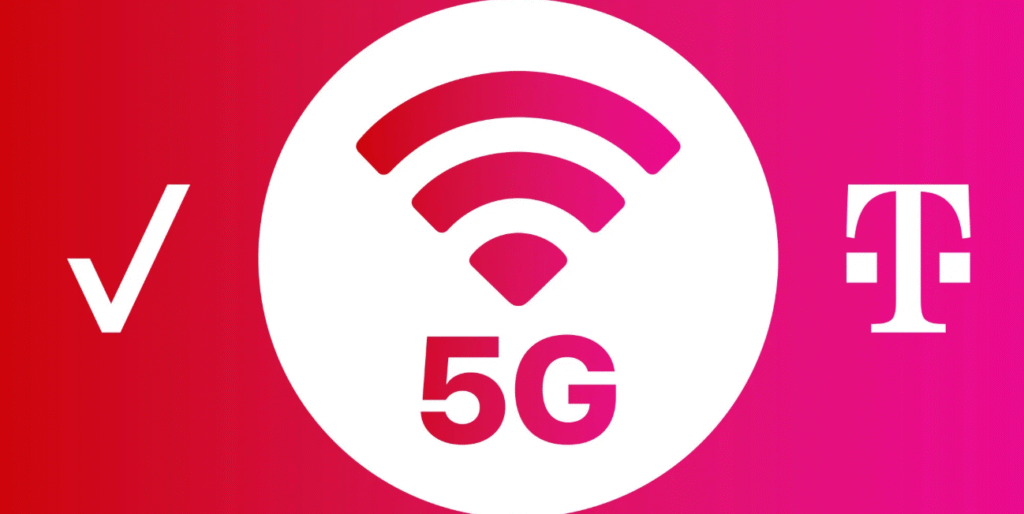Introduction
As the demand for fast, affordable, and flexible home internet grows, T-Mobile 5G Home Internet has emerged as a strong alternative to traditional cable and DSL providers. Using its expansive 5G network, T-Mobile delivers wireless broadband directly to your home—no cables, no technician visits, and no long-term contracts. But how do you know if you’re “in the zone”? That’s where the T-Mobile 5G Home Internet coverage map comes in.
Whether you’re in a bustling city or a quiet suburb, checking your address against T-Mobile’s coverage by ZIP code can help determine eligibility. With average speeds between 100–300 Mbps and unlimited data, the service is ideal for streaming, remote work, online classes, and everyday browsing. This article walks you through everything you need to know—from understanding the coverage map to comparing T-Mobile with other internet providers.
If you’re considering cutting the cord or just want a reliable, contract-free internet option, this guide will help you decide if T-Mobile 5G Home Internet is the right fit for your home. Let’s dive into how it works and whether your location qualifies for high-speed wireless internet.
2. What is T-Mobile 5G Home Internet?
T-Mobile 5G Home Internet is a fixed‑wireless broadband service that delivers high-speed internet to your home using T-Mobile’s nationwide 4G LTE and 5G network—no traditional cable or fiber required. Unlike mobile data, this service uses a small 5G Gateway device (Wi‑Fi router) that you plug into an outlet—set it up in minutes, and you’re online, contract-free and hassle-free.
This service is ideal for homes in urban, suburban, and increasingly rural areas, offering speeds typically ranging from 87–415 Mbps, depending on your location, signal strength, and time of day. T‑Mobile offers three main plans—Rely, Amplified, and All‑In—all include unlimited data, no usage caps, and a five-year price lock, with VPN router, Wi‑Fi 6, and optional streaming perks on higher tiers.
Key selling points of T-Mobile 5G Home Internet include:
- Self-installation: Plug in the gateway, connect to Wi‑Fi, and go online—no technician required
- No contract or hidden fees: Transparent pricing with no equipment costs or early termination fees
- Unlimited data: Great for streaming, video calls, and general browsing
- Money-back guarantee: You can try it risk-free for 15 days with a full refund if it doesn’t work for you
3. Understanding the T-Mobile Coverage Map
The T‑Mobile 5G Home Internet Coverage Map is an interactive tool on T‑Mobile’s website that helps you check whether your location is eligible for the fixed-wireless service. It shows both 5G and 4G LTE coverage areas, and allows you to enter your street address or ZIP code to get address-level service availability.
On the map, areas shaded in magenta or purple typically indicate where 5G Home Internet is available, while other colors (lighter or gray) may denote 4G LTE coverage or areas not currently supported. Hovering or tapping on a specific location brings up a popup with more details—such as whether 5G Extended Range or Ultra Capacity (mid-band/mmWave) is supported.
It’s important to note that the map reflects approximate availability, based on T‑Mobile’s data and the FCC’s fixed-broadband filings. Even if you see coverage, performance can fluctuate depending on factors like tower distance, obstacles, or network congestion during peak hours.
The coverage map is updated regularly (often monthly), reflecting T‑Mobile’s expanding network in new cities and regions. As of early 2025, over 90% of U.S. homes are within coverage zones for the service. BroadbandNow reports that T‑Mobile serves about 60–90% of households across most East Coast, Midwest, and southern metro areas—but far fewer in remote Western regions.
4. How to Check If You’re Covered
Curious whether T‑Mobile 5G Home Internet is available at your location? Here’s a simple step-by‑step guide to check:
- Visit the Eligibility Page
Head over to the official T‑Mobile Check Eligibility portal on their home internet site. Enter your full street address (and unit number if applicable) into the address field and select the correct option from the dropdown suggestions.
- Check Your Results
After submitting your address, the system instantly checks service availability. If you fall within a 5G Home Internet coverage zone, you’ll see a message confirming availability, along with plan options. If not, you’ll be prompted to join a waiting list and notified when coverage becomes available.
- Understand What “Available” Means
“Coverage” means your address lies within T‑Mobile’s home internet zone—typically shown in magenta on their broader coverage map. However, actual speeds can vary based on factors like distance from the tower, topography, or even building materials.
- Use Third-Party Tools for Context
Platforms like BroadbandNow offer interactive ZIP‑code searches and coverage visuals, confirming whether your neighborhood is likely supported. These tools help validate the official result and provide insight into regional rollout progress.
- If You’re on the Edge
If the system says you’re just outside the coverage zone, consider asking neighbors if they have service, or monitor updates—T‑Mobile regularly expands coverage. You might also join their waiting list to be alerted when capability reaches your address.
This quick check helps you determine if you’re truly “in the zone.” If 5G Home Internet isn’t available yet, you can stay informed as coverage grows nationwide.
5. Areas with Strongest Coverage
T‑Mobile’s 5G Home Internet is most widely available in densely populated regions across the East Coast, Midwest, and the South, where network buildout is well advanced. According to broadband data providers, nearly 75% of households in these regions have access to T‑Mobile’s home internet service, with the greatest availability clustered around major metro areas like New York City, Boston, Chicago, Atlanta, Miami, and Philadelphia.
Supported by T‑Mobile’s vast Extended Range 5G network—which covers approximately 98% of the U.S. population—these areas benefit from consistent low-band 5G signal strength, which averages around 100 Mbps in real-world Home Internet usage. T-Mobile’s Ultra Capacity (mid‑band/mmWave) is also growing rapidly: it now serves nearly 83% of Americans, delivering speeds up to 3.3 Gbps in supported cities.
On a state level, coverage is strongest in populous states like New York, California, Texas, Florida, Ohio, and Pennsylvania, where high customer demand has driven aggressive 5G deployment. Rural and remote parts of the Mountain West and northern regions still lag behind, although low-band 5G often still reaches many of these zones—even where fiber or cable aren’t available.
📌 Highlights of Strongest T‑Mobile 5G Home Internet Coverage:
- Urban/Metro Regions: Excellent coverage in major U.S. cities, delivering consistent high-speed performance.
- Suburban Areas: Near-complete availability in densely populated suburbs of the East and Midwest.
- Rural Zones: Select rural corridors receive low-band 5G service, especially where other broadband options are limited.
In summary, if you’re located in or near a major metro area in the East, Midwest, or South, there’s a high chance your home is well within T‑Mobile’s 5G Home Internet zone. Rural users may still qualify thanks to low-band service, but availability is more variable.
6. Limitations and Grey Zones
While T-Mobile 5G Home Internet offers impressive coverage and convenience, it’s important to understand its limitations and grey zones before signing up. Coverage maps may show availability, but real-world performance can vary due to several factors.
One of the most common limitations involves signal strength and reliability. Even if your home is within a 5G zone, obstructions like tall buildings, trees, or hills can weaken the signal. Homes built with concrete or thick insulation can also block 5G signals, leading to slower speeds or dropped connections—especially if the gateway is not placed near a window or open area.
Grey zones are areas where service technically exists, but quality is inconsistent. These are often found near the edge of a coverage zone, where speeds may fluctuate between 5G and 4G LTE, or where congestion during peak hours can slow down performance. Users in grey zones may experience buffer delays or lower-than-expected download speeds.
Additionally, weather conditions can sometimes interfere with fixed wireless signals. While 5G is generally more robust than satellite internet, heavy rain or storms may slightly affect signal quality.
T-Mobile continuously expands and upgrades its network, so areas that are inconsistent today may improve soon. However, it’s wise to test the service during the trial period and monitor performance in your specific location—especially if you’re relying on it for remote work, streaming, or online gaming.
Understanding these limitations will help you make an informed decision before switching to T-Mobile 5G Home Internet.
7. How T-Mobile Compares to Competitors
T-Mobile 5G Home Internet stands out as a strong contender in the growing landscape of fixed wireless and broadband internet services. But how does it compare to competitors like Verizon 5G Home Internet, AT&T Internet Air, Starlink, and traditional cable providers?
📶 Speed & Performance
T-Mobile delivers typical speeds of 100–300 Mbps, which is fast enough for streaming, video calls, online gaming, and working from home. While Verizon sometimes offers higher speeds (up to 1 Gbps in mmWave zones), its availability is more limited. AT&T Internet Air is still rolling out and may not match T-Mobile’s footprint. Starlink offers global satellite coverage but is pricier and less stable during poor weather.
🌍 Coverage
T-Mobile currently reaches over 90% of U.S. households, especially in urban, suburban, and select rural areas. It beats both Verizon and AT&T in national 5G home internet coverage, though traditional cable providers still dominate in high-density neighborhoods. Starlink has the edge in remote and mountainous regions.
💰 Pricing & Contracts
T-Mobile keeps it simple—no contracts, no hidden fees, and plans start at $50/month with autopay, including equipment and taxes. Verizon and AT&T have similar pricing but may include installation or equipment fees. Starlink costs around $120/month plus a one-time hardware fee.
⚙️ Setup & Flexibility
Unlike cable or DSL, T-Mobile’s self-install gateway lets you set up in minutes. This makes it a great option for renters or users seeking a portable, contract-free solution.
8. Tips Before Signing Up
Before you jump into a T-Mobile 5G Home Internet plan, there are a few important tips to ensure it’s the right choice for your needs.
1. Check Precise Coverage at Your Address
While T-Mobile’s coverage map is a great starting point, always use their address checker tool for the most accurate results. This ensures you’re not in a grey zone with spotty or inconsistent signal quality.
2. Use the 15-Day Risk-Free Trial
T-Mobile offers a 15-day trial with a money-back guarantee. Take advantage of this period to test speeds at different times of the day. This is especially useful if you’re using the internet for remote work or gaming.
3. Gateway Placement Matters
Signal strength can be greatly affected by where you place the T-Mobile gateway. For the best results, position it near a window or open space—avoid corners, closets, or basements.
4. Compare with Local Alternatives
If you live in an area where fiber or high-speed cable is available, compare prices and speeds before making a final decision. In some cases, traditional broadband may offer faster or more consistent performance.
5. Join the Waitlist if Needed
If your address isn’t currently eligible, join the T-Mobile waitlist. Coverage is expanding rapidly, and you’ll be notified when service becomes available in your area.
Taking these small but crucial steps can help ensure a smooth and satisfying experience with T-Mobile 5G Home Internet.
9. Frequently Asked Questions
Below are some of the most common questions about T-Mobile 5G Home Internet, designed to help you make an informed decision. We’ve included answers using highly searched keywords like T-Mobile 5G coverage map, availability by zip code, gateway setup, and more.
🔹 How do I check if T-Mobile 5G Home Internet is available in my area?
To see if you’re in the coverage zone, use the T-Mobile 5G Home Internet availability checker on their official website. Simply enter your zip code and address, and the system will tell you if service is currently available or if you can join the waitlist.
🔹 What does the T-Mobile 5G coverage map show?
The T-Mobile 5G coverage map visually displays areas with Extended Range 5G and Ultra Capacity 5G. Magenta zones usually indicate full 5G access, while lighter areas may fall under 4G LTE. The map is updated frequently to reflect expanding network support.
🔹 Is there a data cap?
No, T-Mobile offers unlimited data with their 5G Home Internet plan. There are no data caps or overage fees. However, speeds may temporarily slow during periods of heavy network congestion.
🔹 What is the typical internet speed?
Most users report download speeds ranging from 100 Mbps to 300 Mbps, depending on their proximity to a T-Mobile tower, signal strength, and network traffic. In Ultra Capacity zones, speeds may exceed 500 Mbps.
🔹 How is the T-Mobile 5G Gateway installed?
Installation is self-service and takes only a few minutes. Once you receive the gateway, plug it in near a window or open area, follow the app setup, and you’re online. No technician or wiring is required.
🔹 Can I use T-Mobile 5G Home Internet for gaming or streaming?
Yes! It works well for 4K streaming, online gaming, and video conferencing. Gamers should test ping times during the 15-day trial to ensure responsiveness meets their needs.
🔹 What if I move to a new address?
T-Mobile allows you to move the gateway to a new location. Just re-check availability by ZIP code for your new home, and if service is available, plug in and go.
10. Conclusion
T-Mobile 5G Home Internet is quickly becoming a game-changer for households seeking affordable, high-speed, and contract-free broadband. With wide availability across urban and suburban areas, easy self-installation, and unlimited data, it’s a great fit for streaming, remote work, and everyday browsing.
While the T-Mobile coverage map is a helpful starting point, always confirm availability at your specific address. Don’t forget to take advantage of the 15-day trial to test speeds and stability in your home environment. Whether you’re switching from cable or looking for a better alternative in rural areas, T-Mobile 5G Home Internet offers a competitive blend of flexibility and performance. As network expansion continues, more users across the U.S. will benefit from T-Mobile’s growing 5G footprint. With the right expectations and a bit of planning, you could be just a few minutes away from fast, reliable internet—no wires, no hassles.



